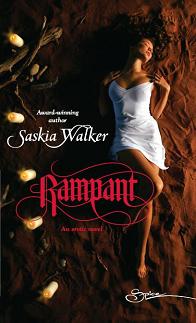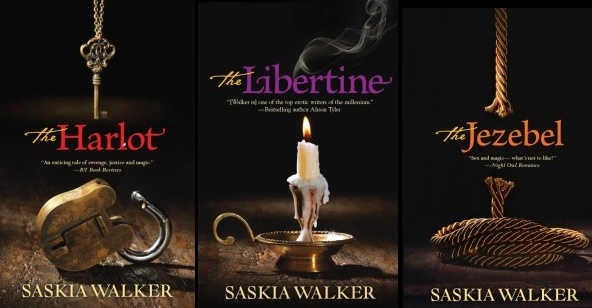First and foremost my novel length writing is erotic
romance, but when we write these kind of stories we know that everything about a character's life from their background to their
physical location will influence the way they interact and have relationships. I
love exploring relationships and I also love the challenge of meshing external and
internal conflict for my characters. I can spend hours thinking about the
problems that setting and motivation can bring to a budding love story! Writing
about love affairs during passionate, turbulent times in Scotland during the early 1700s was
perfect for me. Running alongside the troubled history and the uneasy union with England
is the history of persecution for witchcraft. In other words, there was a hell
of a lot going on! Danger came in many forms during those times, and that big
picture filtered down through my imagination forming into intriguing individual life
stories.
The three Taskill novels, THE HARLOT, THE LIBERTINE and THE
JEZEBEL, and one previous stand alone novel, RAMPANT, were all inspired by visits
to Scotland and learning
about the history of witchcraft and persecution there – particularly in the Lowlands . My interest in sexuality and eroticism meant I
grabbed the chance to write about characters who might explore sexmagic—the
belief that the vital life energy inherent in physical and emotional love can be
channeled and used in magical ways. (Yes, there will be a whole post about
that later on. ;)
Why the Lowlands ? The more enduring
image of Scotland in fiction
is the rugged, romantic Highlands . Ultimately
that's because the trials went on in the Lowlands. Anything with a mystical or paranormal aspect was much more readily
accepted in the Highlands . Distance from the
seat of government and the deeper connection with the land and the elements no
doubt led to a more whimsical acceptance of the unknown. However, in the Lowlands
of Scotland society was more developed during the period I am writing in, and
the laws of church and king defined the culture in a much more tangible way.
I visited the East Neuk of Fife
around 8 or 9 years ago. I'd visited the cities and Highlands before, but there
was something about the Kingdom of Fife and the East Neuk
in particular that really captured my imagination. Of course I was already a published
writer by that point. In fact part of the reason for the stay was to write
while my Real Life Hero went off mountain biking. We stayed in a tiny fisherman's
cottage right on the seafront and I quickly abandoned the project I'd taken
with me in order to make notes about my surroundings, together with ideas about
the people who might have lived there. Whilst in the area I investigated the local
history and the folklore, something that always interests me. That in turn led
me to the history of persecution that still burdens Scotland today.
In 2008 a petition was presented to government requesting
the pardon of over 2,000 individuals who were tortured and put to death in Scotland 's
history for practicing witchcraft. (You can read about the petition here at the BBC)
Those people were often buried in unmarked graves after being put to death, deaths that were justified by confessions that had been elicited from them via cruel torture and
deprivation. Later on I'll explore some of the artifacts that have been
salvaged from the time of the witch trials. It's a dark history, and that
together with the wild, beautiful landscape inspired me to write about fictional
characters who found ways to survive and scrabble a living—to live and love and
pursue the goal of escaping their fraught history.
While I was in Fife and
afterwards my mind ran with questions. What if you were a gifted healer, knew a
few things about herbs and how best to treat someone with an illness? Instinct
leads people to mistrust and fear what they don't understand. The church cast a
long shadow over gifted healers, relating it to evil, satanic ways. And of
course it's a handy mechanism for a cruel person to get rid of the hated neighbour, point the
finger and say that you saw them cursing the cow's milk making it turn sour. Yes,
people were put to death for the most insubstantial things being seen as
evidence of evil and witchcraft.
Being a writer my "what if?" manner of thinking
soon led me to a whole scenario where people who were *really* gifted with the
craft lived in fear of being discovered. Beyond healing, the fictional
characters I write about pass down ancient Celtic and Pictish magic from
generation to generation – secretly. It was the secret nature of the characters
and the world I wanted to write about that appealed to my editor at Harlequin.
 The first "witch" character I wrote about was
Annabel McGraw, who appears in a historical backstory in the contemporary novel
RAMPANT. Annabel was inspired by that fishermen's cottage that we stayed in the
East Neuk of
The first "witch" character I wrote about was
Annabel McGraw, who appears in a historical backstory in the contemporary novel
RAMPANT. Annabel was inspired by that fishermen's cottage that we stayed in the
East Neuk of
Before we'd even left Fife Annabel was fully formed in my
mind. Although she's not the heroine in RAMPANT she is the catalyst for the whole
story. She's a very bad girl in many ways, but ultimately knows she's done wrong and she has a good heart.
I fell so in love with her story that I wanted to write about more characters
who might have lived in that historic world – where the fear of persecution rules
you, where everything you do and think can be held accountable because you are
gifted in ways that people around you do not understand.
That's how I came to write about the Taskill witches,
starting with Jessie in THE HARLOT. (This is the UK cover shown on the right.) The more I read about the witch trials and
what had gone on, it made me wonder what if a woman was put to death and she
had children? What happened to her children? Would they forever be shamed,
perhaps even marked out as potential tools of Satan? What would their lives be
like, haunted by the memory of their mother's persecution and death? What if
they were split up and had to hide their skills, alone and frightened, to survive? Would they grow up angry, stubborn, or afraid? How would they earn a living, and how would they ever find each other again, in a world where suspicion was rife? Yes, the
"what if?" mind of a writer can take you on some interesting
journeys. ;o) I wouldn't trade my imagination for the world.
Next week I'm going to talk about why the laws on witchcraft
came to exist, the grip they held on society, and when they were broken down.
My Taskill novels are set towards the end of the period covered by the laws
governing witchcraft. That's because I wanted to write in the time when change
was afoot. Often the prospect of change makes things more difficult at first, it's not black-and-white any more
and the muddied waters make it hard to know who to trust. By the early 1700s
people had begun to question the laws on witchcraft. Perhaps if you were gifted
with the craft and wanted to help someone who was sick, you might ask yourself can
I trust them? Especially if it was someone in power.
Until next Witches on Wednesdays I'll leave you with some resources
about Fife , where I was so thoroughly inspired.
:) First up is some footage of the East Neuk
from talented enthusiast Andy Campbell. In the first video you'll see the villages of the East Neuk, including Crail,
which is the model for the village
of Craigduff
In the footage below you can virtually-visit St Monans, which is the model for Carbrey in RAMPANT.
Here are some useful links for more info on Fife :
You can find
excerpts from the books here:
THE HARLOT
THE LIBERTINE
THE JEZEBEL
RAMPANT
THE HARLOT
THE LIBERTINE
THE JEZEBEL
RAMPANT


